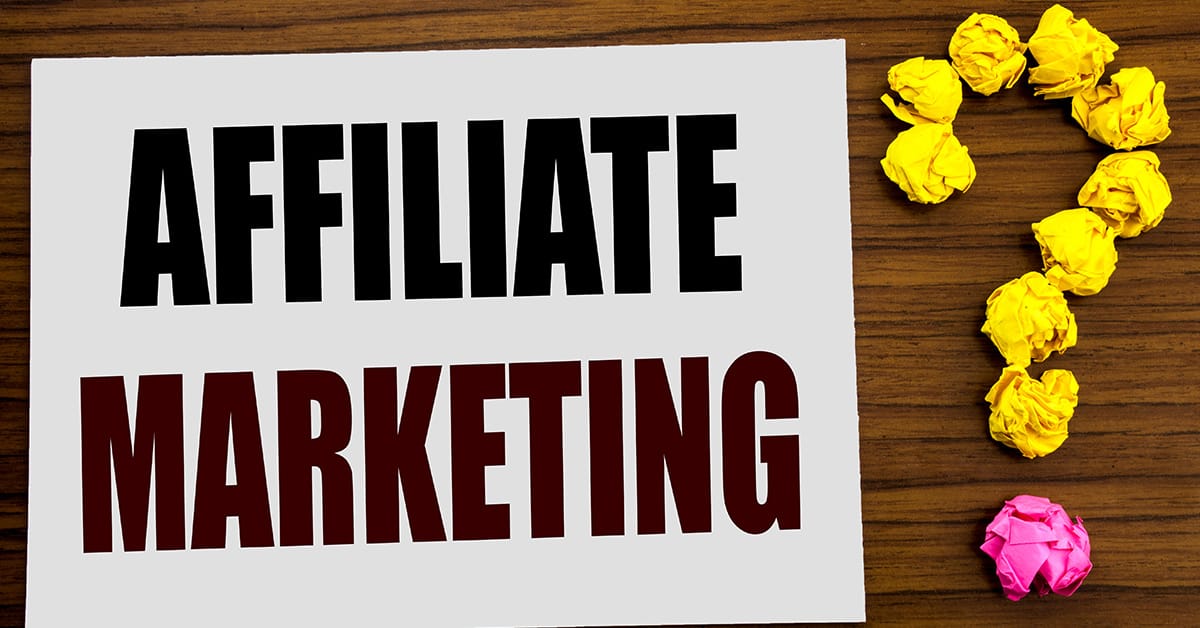So, you’re new to affiliate marketing and ClickBank, and you want to make money online as a successful affiliate?
Then you’re in the right place!
Our goal has always been to provide new affiliates everything they need to be successful online. To help accomplish this, we’ve put together a complete list of the biggest questions we get from new ClickBank affiliates in this epic affiliate marketing FAQ guide.
Along with more than 25 in-depth affiliate questions and answers, we also have a FULL starter guide to point you in the right direction. Check out our in-depth ClickBank for Beginners tutorial – or our guide to getting your first ClickBank sale – for step-by-step advice on launching and growing your affiliate marketing career!
And now, onto the questions!
[hubspot portal=”5154711″ id=”7642b9fe-5d46-49e7-aa54-737c33f9221c” type=”form”]Affiliate Marketing Frequently Asked Questions
Section 1: General Affiliate Marketing Questions
Section 2: Getting Started on ClickBank Questions
Section 3: Creating and Testing HopLinks Questions
Section 4: Traffic Channel Questions
Section 5: Analytics and Tracking Questions
Section 6: Spark by ClickBank Questions
Section 1: General Affiliate Marketing Questions
1) How do I make money online?
That’s a fair question! A lot of people know there’s a way to make good money over the internet… somehow…
But actually understanding the FULL picture? That’s more complicated.
Obviously, there are LOTS of ways to make money online – I even wrote a detailed article about 17 of the most popular ways to make money online.
But if you want the cliff notes version, here are a few of the top ones:
- Affiliate marketing
- Ecommerce
- Freelancing
- Selling or renting physical goods online
- Blogging
- YouTube
- Social media influencing and streaming
On the ClickBank platform, we help all kinds of businesses grow and scale, but we’re primarily built for people with a product to sell (ecommerce sellers) or people looking to promote products in exchange for a commission (affiliate marketers).
While ecommerce is a lucrative opportunity, we firmly believe that affiliate marketing is the best way to get started for online business newcomers.
2) What is affiliate marketing?
If you’re interested in affiliate marketing, but you don’t fully understand what it is, here’s a quick rundown:
As an affiliate, your entire job is to send users to the sales page of another company’s product. When your visitors go on to make a purchase there, you get a commission from the sale.
For a quick example, my hobby songwriting blog uses banners and text affiliate links to promote music products listed here on ClickBank. One ClickBank digital course I promote teaches people how to play piano. It costs $39 in total, and I get a 60% commission on that, or roughly $22 per sale.
This example encapsulates the TWO ingredients you need for a successful affiliate marketing business:
- Traffic
- Conversions
Let’s look at both real quick.
Traffic
Traffic refers to the users you send over to an offer. Typically, traffic comes from either free or paid sources.
In general, common organic (free) traffic sources include:
- Email marketing
- Organic social media (Facebook Groups, Pinterest pins, tweets, Instagram posts, etc.)
- Blogs
- YouTube videos
For these platforms, your goal is to create content that informs, educates, or entertains an audience, and then encourage them to click your affiliate link.
Alternatively, you can go the paid route. Popular paid traffic sources include:
- Facebook Ads
- Google Ads
- YouTube Ads
- Native ads
With paid ads, you’re still creating content, but it’s put in front of “cold traffic,” or people who are encountering you for the first time. This means you need to grab attention and move them quickly through the stages of the buyer’s journey to get them ready to buy.
Conversions
Whichever way you choose to get in front of an audience, your next step is to convince them to click through to a sales page. In other words, your job is to “sell the click.”
After a user lands on a sales page, the rest of the selling process is out of your hands – which means you need to do your due diligence upfront and pick a solid offer that people will want to buy.
If you add an affiliate tracking link to your organic traffic channel, you’ll get credit when someone clicks it and then buys something. To learn more, visit our guide covering traffic sources and affiliate link strategy.
3) I keep seeing you guys use acronyms like EPC and AOV. What the heck do all these affiliate terms mean?
If you find yourself at a loss with acronyms like EPC, AOV, LTV, CPA, PPC, and VSL, don’t worry – it’s not as hard as it seems to understand all this affiliate marketing jargon!
Even I was able to figure them out when I wrote up an entire affiliate marketing glossary that defines and dives into all of the most important affiliate marketing terms you’ll come across. Use it as a reference guide whenever you need a refresher.
4) How much can I earn as an affiliate?
Technically, there is no upper limit to your potential earnings as an affiliate!
I can tell you that top ClickBank affiliates bring in six or even seven figures per year. With that said, it can take a LOT of time to build up that level, because you’ll likely need expertise in one or more marketing channels and niches. At that level, you’re also likely to have your own product(s) for sale – although this isn’t always the case.
Lastly, to support a high level of success, you may have expenses you didn’t think about. This could involve hiring a small team of people, managing a paid traffic budget, maintaining a website, and covering ongoing software subscriptions (e.g. a funnel builder like ClickFunnels, an ad analytics tool like Voluum, an SEO tool like Ahrefs, etc.).
The good news is, plenty of people find great success as an affiliate. Each year, tens of thousands of affiliates earn on ClickBank’s platform! (Find out more about whether affiliate marketing is worth it.)
5) How do I get started in affiliate marketing without a website?
This is a question we get a lot, and for good reason: many people don’t want to worry about building and maintaining a website. It can be a big investment of time and money, and there’s definitely a learning curve if you’re new to managing websites.
Fortunately, you have a LOT of different ways to make it as an affiliate without your own website! You can focus on organic social as an influencer, paid social as a media buyer, email marketing, YouTube, or even online communities like Reddit and Quora.
Just note that many affiliate programs and advertising platforms do want you to have some kind of basic website – in those cases, you can quickly register a domain name through Bluehost and put together an easy one-page site using a funnel builder like ClickFunnels.
To learn more, check out our guide on how to promote ClickBank products without a website.
Section 2: Getting Started on ClickBank Questions
1) How do I get started as a ClickBank affiliate?
This here is the million-dollar question.
Of course, there’s no one-size-fits-all answer for it, but I can walk you through the basics.
First, you’ll need to get set up with an account. When signing up for a ClickBank account, you’ll need to enter all of your basic information. Then, just hit “Join ClickBank” and you’re in!
From here, you should set up your client profile and payment information. For more detailed signup instructions, read this article.
2) How do I set up my account nickname inside ClickBank?
If you don’t understand how it works, this can be a little tricky.
Basically, there’s a master account and then there are your account nicknames, which serve as the “ID” for your tracking links. You can set up the account nickname inside your master account dashboard by going to Accounts > Create an Account. If you already have an account nickname, click on it to take you to your account for reporting and analytics.
For more information on this, please read this article.
3) Why am I unable to sign up on ClickBank? How do I get approved?
The ClickBank marketplace is a massive global affiliate network that connects affiliates and sellers around the world.
While the majority of our customers use the service as intended, ClickBank reserves the right to disable accounts or prevent signups that may pose a risk. We do this to ensure a quality experience for all and to prevent fraud or compliance issues.
If you feel your account has been disabled wrongly, please contact support here.
4) What do the ClickBank marketplace stats mean?
There are a handful of general stats found in the ClickBank marketplace that can help you find an offer that’s right for you.
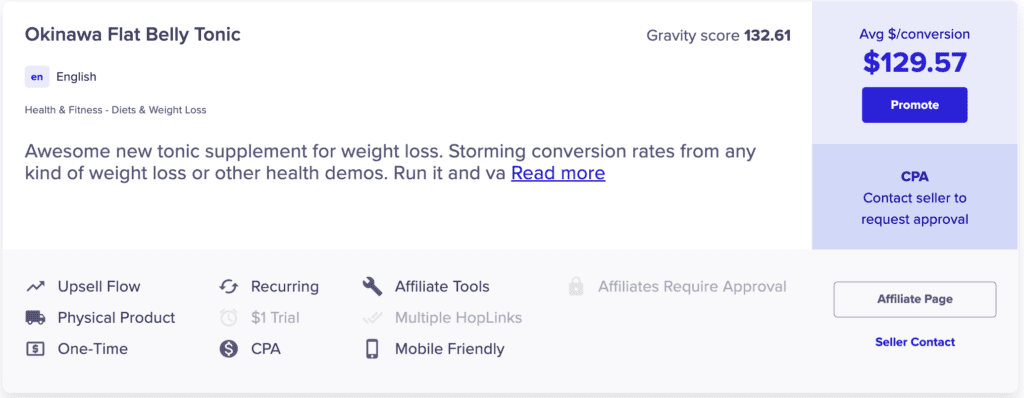
Here’s a quick rundown on each stat you’ll find in a product listing.
Avg $/Conversion:
Avg $/conversion refers to the average commission that an affiliate earns for each conversion on a seller’s offer within the RevShare commission structure. This number includes earnings from total sales (adding up all initial sales, upsells, and rebills).
Initial $/Conversion:
The initial $/conversion refers to the average commission an affiliate will earn on the initial purchase for a seller’s offer, including the commission from any upsells or order bumps on this first sale. What it does NOT include is any affiliate earnings from rebill payments of subscription products. You will only see this stat on a product listing if the product has an ongoing membership fee or subscription.
Recurring $/Rebill:
The recurring $/rebill number is the average commission an affiliate earns for each rebill payment of a seller’s product(s). You only see this if the sellers offers recurring products.
Grav:
Grav is short for the GRAVITY™ performance statistic. This number represents a unique calculation by ClickBank that takes into account the number of different affiliates who earned a commission by promoting this product over the past 12 weeks. It can give you an idea of which products are “hot” at the moment, in terms of being promoted by many affiliates and making a good number of sales.
Learn more about Gravity in our ClickBank Gravity Score guide.
Cat:
Cat is short for Category. This section reveals the product’s official ClickBank marketplace category and subcategory – also commonly referred to as an affiliate marketing “niche.”
5) Do I need third-party tools to be successful on ClickBank? If so, which ones?
I’m going to level with you: additional tools are super helpful in this space!
If you’re determined to go the free or low-cost route, you don’t necessarily NEED any paid tools, but they’ll make your job a LOT easier! Sometimes, you can find free tools that are good enough for the time being and invest in better options down the road when your business has the income to cover the costs.
On the other hand, for some marketing approaches, paid tools are basically a requirement. Here’s a quick list of the types of tools you should consider:
- Ad trackers
- Funnel builders
- Web hosting
- Membership sites
- Email service providers (ESPs)
- Third-party logistics (3PLs) and fulfillment
- Integrations
- Payment tools
For a full list of recommended tools, visit the ClickBank partners page.
Section 3: Creating and Testing HopLinks Questions
1) How do I create a ClickBank tracking link (HopLink)?
The HopLink is a special ClickBank tracking link that you can place all over the web. It’ll give you credit for any sales you generate!
Fortunately, creating a HopLink is very easy. You can do it a few different ways, but here’s the most common one:
- Inside the ClickBank marketplace in your account, find a product you’re interested in. Click the “Promote” button within a product listing and then click “Generate HopLink.” From there, you can copy the link and then paste it where you want to promote the product.
To learn more, check out our full guide on creating a HopLink.
2) How do I know if my HopLink is working?
Once you create a HopLink, you can easily test it by placing it somewhere (ie an email, blog post, ad, etc.) and then clicking it to see where it directs you.
Follow the link to your chosen offer’s sales page. When you click the buy button on this page, it’ll take you to a ClickBank order form. Scroll down to the bottom of the form and make sure you see your affiliate nickname there. This means your HopLink is working and you’ll get credit for any sales.
3) What is an affiliate tools page?
An affiliate tools page is a resource page provided by the seller of an offer. It often contains battle-tested resources like:
- Email swipes
- Banner ad creative
- Demographic info
- Landing page URLs
- Affiliate link generators
… And anything else that can help affiliates promote products better. Here’s an example of a tools page for the product Vista Clear:
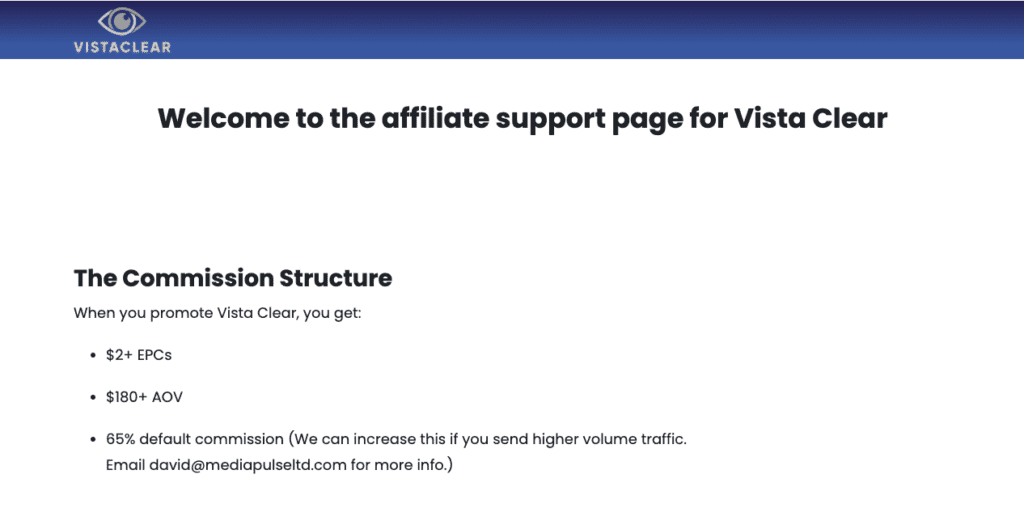
4) How do I contact sellers as an affiliate?
In many ClickBank product listings, you’ll see a contact email you can reach out to by clicking the Seller Contact link.
For example:
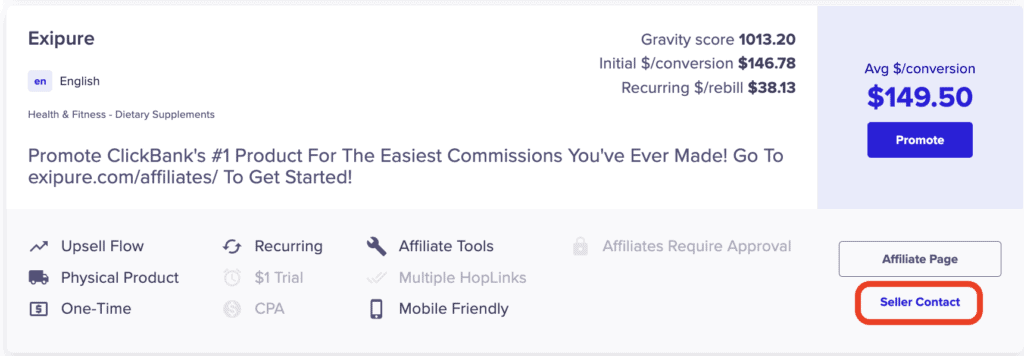
If they don’t list the contact info there, but they have an affiliate page, you’ll likely find a way to reach out to them there.
NOTE: Not all offers will have a contact. It’s up to you whether having a contact you can connect with is important – but for higher-ticket offers, establishing a relationship with the offer’s product owner or affiliate manager is a great idea.
5) How do I vet a potential offer?
Everyone has their own ideas about what makes a good offer. These factors can include the actual offer stats, like conversion rate, Gravity Score, avg $/conversion, and commission % or CPA rate.
Other factors include the quality of the sales page, the availability of additional resources on an affiliate tools page, and a direct contact you can talk to. Some people are only looking for CPA offers, while others are very particular about product niche or category. Some people prefer offers that require you to apply, while others appreciate the ease of access from offers you can promote right away!
No offer is perfect – and if you ever find one that is, it probably won’t stay that way for long, because lots of people will jump on it and promote it until the market is saturated. But hopefully, these criteria give you an idea of what to think about when you vet a new offer.
6) How do I decide which offer to promote? What products should I promote?
Realistically, the ONLY way you can know for sure which products to promote is by getting out there and promoting something, seeing how it goes, and either doubling down or pivoting to something new.
Like with any business, it’s about understanding the marketplace and your position within it. You need to find the sweet spot between your expertise and market demand. For example, if you’re the world’s foremost expert on bottlenose dolphins, but there isn’t anyone looking for bottlenose dolphin products online, that’s probably not a great moneymaking niche.
On the other hand, picking a massive and popular niche that you know nothing about isn’t wise either, unless you’re determined to fill in your knowledge gap quickly. No matter which niche and traffic sources you choose, you’ll need to understand your audience, know the available solutions to their pain points, and find a way to position the products you’re promoting to get their attention.
If you know the niche you want to focus on, the next step is picking the right offer in it. You can filter by category in the ClickBank marketplace, so scroll through and take note of the stats for each offer. You want a decent Gravity score (ideally 20+), but unless you’re an expert, don’t go so high (150+) that you’ll be drowned out by the competition.
For additional help on how to choose affiliate products to promote, please see these top products resources that reveal what performs well on ClickBank:
- Monthly ClickBank top products
- Best Selling ClickBank Products of All Time
- Best Supplement Affiliate Programs
- Best Weight Loss Affiliate Programs
7) Which ClickBank product category/niche has the best conversion rates?
Typically, we see the highest average payout value with e-business offers, especially those with some kind of coaching included. We also routinely see $100+ average payouts for physical health and fitness supplement products.
Conversion rates tend to be higher for lower-ticket items and vice versa. That means you’ll have to crunch some numbers to figure out if a lower conversion rate on high-ticket affiliate offers is better for your bottom line, or if a higher conversion rate on lower-ticket offers make the most sense for you.
You can learn more about in our guide to the 10 best affiliates niches on ClickBank in 2022.
Check out our Marketplace to get started.
8) I have been watching the “top products” episodes on YouTube. As a beginner, should I start by promoting those top 10 offers or something further down the list?
Generally speaking, no. It’s better to get your feet wet on less competitive offers. These high-gravity offers are getting a lot of sales, but depending on where you’re promoting them, you’re competing with a large group of other affiliates, which can drive up your costs and make it harder to see profitable results.
If you go just a page or two deeper in the marketplace, you’ll find some competitive offers that still convert quite well. The decision on what to promote is ultimately up to you, but we do recommend starting small until you get more comfortable with the process as an affiliate marketer.
Section 4: Traffic Channel Questions
1) How do I get free traffic?
We have countless resources that dive into getting free traffic. It boils down to organic traffic sources like blogs, YouTube channels, social media, and email.
For more information, watch the above YouTube video or check out this guide to free traffic.
2) How do I get started promoting products with paid ads (ie Facebook)?
Facebook can be a tough nut to crack for new affiliates, but it still has a lot of potential.
Here’s what we recommend:
- Read Facebook advertising policies thoroughly and follow the rules the best you can.
- Build an affiliate bridge page to use between your ad and the offer’s sales page. Facebook doesn’t like affiliate links used directly in ads.
- Expect ad account shutdowns. You’ll need to chat with support to get your account back online.
- Focus on creative and metrics around creatives for initial feedback to help you figure out what’s getting the highest engagement. These KPIs include cost per link click, clickthrough rate (CTR), etc.
- Make sure you set up pixel and CAPI tracking correctly. (See our Integrated Sales Reporting how-to guide for more on this.)
- Don’t feel like you need to be super narrow with your targeting in the beginning. Facebooks AI is REALLY good and will learn who your customers are. Sometimes, giving them larger audience pools to work with will yield better results than narrowing down on a very select and small group of demographics that you think fit the ICP for the product you are promoting.
Lastly, we suggest that you test, test, test, and protect your margin. Start low with lower price-point items before you start spending a lot.
3) How do I make a landing page? What’s the difference between a landing page vs. a bridge page?
No matter which traffic source you’re using, chances are good you’ll want a landing page between your ad and the offer.
This specific type of landing page is often called a “bridge page” or “presell page,” because it warms up traffic and serves as an intermediate page that bridges the gap between a traffic source and an offer. In this graphic, you can see the difference between a funnel with no bridge page versus funnels with a bridge page.
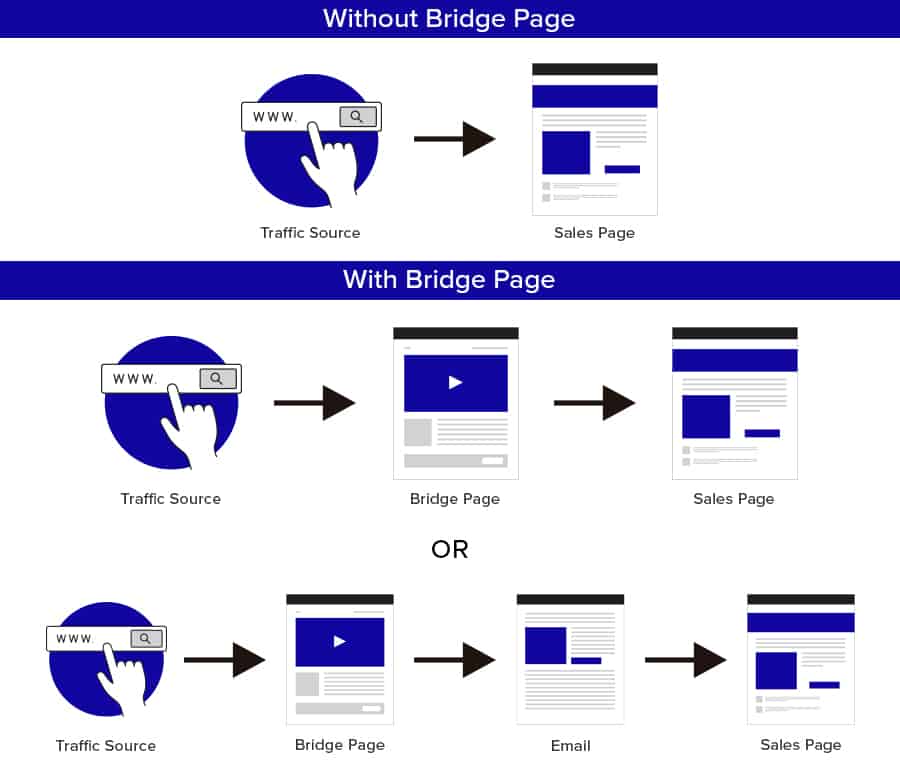
If you have cold traffic, a funnel builder like ClickFunnels or website host like Bluehost can help you get started building out your page.
For more information, we have a great article that goes in-depth on how to make a landing page.
4) How do I get my own email list?
Building and managing your own email list is seen by most as the “holy grail” of marketing channels in our space.
The rule of thumb is that you can make $1 per email address per month on an active, engaged list. So, a list of 10,000 subscribers would equal $10,000 per month. Not bad, right?
But building a quality email list is usually a long-term play, and you’ll need to get email opt-ins from other sources. Here are a few that work really well:
- Your blog or website (with embedded opt-in forms and exit pop-ups)
- YouTube videos (with a link to an email subscribe page)
- Facebook Groups (with the email address as a condition of joining)
- Organic/paid social (with links to an affiliate bridge page for new email signups)
- In-person signups at trade shows (with a tablet to record new emails)
As your list grows, you’ll learn what kind of products sell well and how best to position them to your audience to get more commissions.
Best of all, you can use it not only to sell other people’s products as an affiliate, but eventually as a way to sell a product YOU create!
Learn more about how to do affiliate email marketing.
Section 5: Analytics and Tracking Questions
1) How can I integrate my ClickBank account? How do I track sales using Integrated Sales Reporting?
ClickBank has an Integrated Sales Reporting tool that will help you keep up with data about the sales process.
Our tracking feature integrates with different platforms, including the Facebook Conversions API (CAPI), Google Analytics, and other generic tracking pixels used for third-party ad trackers, native ads platforms, and more.
Check out our full guide to the Integrated Sales Reporting feature.
2) Why does my third-party tracking software show different numbers than my ClickBank account?
This can happen, but reporting on our end is pretty straightforward to set up.
Typically, if there’s a discrepancy, it’ll be on the back-end with Facebook, Google Analytics, or wherever you’re trying to connect.
You can find out more on troubleshooting this in our Integrated Sales Reporting guide.
3) How do I use the Analytics section of my account?
A lot of users don’t realize how much data is accessible inside the ClickBank account. It’s a versatile and crucial tool for any aspiring affiliate to learn.
To access your analytics, go to your chosen account nickname. From there, click the “Reporting” menu option. By default, this will place you in the “Analytics” tab.
In this area, if your chosen nickname is active as an affiliate AND as a vendor, you can pick which one you want to view as in the upper left corner – it’s set to “affiliate” by default.
Next, notice that you have a front-and-center chart with green lines on it. This shares your Hops (ie tracking link clicks) data type by default, but you can change it to display other data types instead, such as order form impressions, order form submits, initial sales, or gross sales.
You should know that transactions are visible in your account within minutes of the activity taking place, so you’ll see fresh data in your account throughout the day.
Section 6: Spark by ClickBank Questions
1) I would love some coaching or additional help getting started in affiliate marketing. What do you recommend?
We have a quality ClickBank blog, YouTube channel, and Affiliated podcast with loads of valuable free content to guide you along your affiliate marketing journey. Be sure to subscribe to all of them.
But if you’re serious about affiliate marketing and want to get up to speed FAST, you need to check out Spark by ClickBank. Spark is our affiliate marketing education platform, where we dive deep into everything you need to know to succeed as an affiliate!
2) Is Spark tied to your ClickBank account? Is Spark required?
No, Spark and ClickBank are independent accounts from each other. At no point will you be required to be a Spark student to use ClickBank.
With that said, a big goal of ours is to have Spark students finding success on ClickBank, because when you do well, so do we. So stay tuned for some exciting, exclusive ClickBank features for Spark students!
3) Why do I need Spark by ClickBank?
The goal behind Spark isn’t to overwhelm you with marketing “information overload,” but to help get you going in the right direction and navigate around the most common affiliate hurdles along the way.
One of the things we often see is that people neglect the “marketing” aspect of affiliate marketing – they try to skip right to Facebook Ads or YouTube or blogging, but they don’t have all the fundamentals. Spark will teach you how to be a marketer first, and THEN a master tactician.
Once you have the foundation down, you’ll be equipped to tackle all-new traffic channels, niches, offers, and skills in affiliate marketing.
For more information on Spark, you can read our full Spark by ClickBank review.
New ClickBank Affiliate FAQ Wrap-up
That was a lot, but it’s our hope that you found answers to all of your big ClickBank and affiliate marketing questions here.
Again, we have a wide range of additional resources and videos throughout the post if you need more information on a specific topic.
Beyond that, give Spark by ClickBank a try to move forward on your affiliate marketing career!


